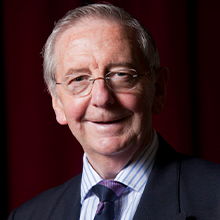Professor Sir John Peebles Arbuthnott BSc, MA, PhD, ScD, FIBiol 1939–2023
08 March 2023

John Peebles Arbuthnott died in February 2023 at the age of 83. He was an honorary member of the Microbiology Society which he joined in 1967. He served the Microbiology Society with distinction as Group Convenor (Pathogenicity) from 1972-1976, as a Senior Editor of the Journal of General Microbiology, now Microbiology, from 1980-1983, as a member of the SGM Council (1981-1985) and as Treasurer from 1987-1992. He was Professor of Microbiology in Trinity College Dublin from 1976 to 1988. In 1988 he returned to the UK to take up the position of Professor of Microbiology at the University of Nottingham before returning to his native Glasgow to become Principal and Vice Chancellor of Strathclyde University, where he remained until 2000. He made an impact wherever he worked both as an academic of international standing and by providing academic leadership at the highest level. In 1998 he received a knighthood for services to education.
Sir John Arbuthnott’s early life and education was in Scotland. Born in Glasgow he attended Hyndland Secondary School and obtained his BSc in Biochemistry and PhD in Bacteriology at the University of Glasgow. He was appointed to Assistant Lecturer in Glasgow in 1960, rising to Senior Lecturer in 1972 in the Microbiology Department (formerly Bacteriology). His developing reputation for research in bacterial pathogenesis was enhanced by a visiting fellowship in 1966 and 1967 to New York University to work with Alan Bernheimer on staphylococcal alpha-toxin. He returned to the University of Glasgow in early 1968 to take up a four year Royal Society Fellowship.
In his academic career Sir John built an international reputation studying bacterial protein toxins, notably the toxins of Staphylococcus aureus. These included the potent cytolytic membrane-damaging alpha-toxin, the epidermolytic toxin responsible for Scalded Skin Syndrome and the superantigen Toxic Shock Syndrome Toxin-1 (TSST-1). In each case he analysed the mechanism of action of the purified toxin and, following the dictum of Harry Smith, was able to replicate aspects of the human disease in appropriate animal models. His work investigating a new disease syndrome in menstruating women called Toxic Shock Syndrome that was attributed to the introduction of super-adsorbent tampons was particularly impressive. Sir John’s research showed that strains of S. aureus isolated from TSS cases elaborated a novel protein toxin called TSST-1. His research proved TSST-1 to be the aetiological agent of the disease.
Sir John was appointed Professor of Microbiology in TCD in 1976. Interestingly Professor Harry Smith, a former president of the Microbiology Society, and a former external examiner to the Microbiology Department in TCD, was instrumental in persuading him to take that post. During his tenure the Department became well known for its output on bacterial pathogens. He obtained funding from the Normanby Trust to build containment laboratories for recombinant DNA research on bacterial pathogens. This allowed the genetic manipulation of organisms such as S. aureus and enterotoxigenic Escherichia coli. Sir John was the Bursar of TCD from 1983-86, experience which served him well when appointed treasurer of the Microbiology Society in 1988. PhD students were always amused to see copies of the Financial Times in his office amid bundles of scientific papers.
Those who worked in the Microbiology Department TCD remember Sir John as a wise and genial mentor of staff and undergraduate and postgraduate students alike. The highlight of the Senior Sophister year was dinner for the whole class in his house where he and his wife Elinor would make everyone welcome. His office door was always open, which might have meant being exposed to plumes of pipe smoke. It was fitting that he was the guest of honour at the scientific symposium in 2003 to celebrate the 50th anniversary of the opening of the Moyne Institute.
In 1988 Sir John took up the position of Professor of Microbiology in Nottingham University before being appointed Principal and Vice-Chancellor of Strathclyde University. He led Strathclyde from 1991 to 2000. This was a period of considerable expansion, during which the former Jordanhill College of Education merged with the University to become its Faculty of Education. In 1998, in addition to presiding over Strathclyde, Sir John was responsible for two major policy reviews in the early years of devolution following the establishment of the Scottish Parliament. He chaired an independent review of resource allocation to NHS authorities, to reflect the social, economic and demographic circumstances of each area, the resulting mechanism becoming known as the Arbuthnott Formula. He also led a commission which assessed Scotland’s varying electoral systems and constituency boundaries following devolution. He subsequently became Chair of NHS Greater Glasgow and Clyde. Sir John’s contributions to Strathclyde University were recognized by a new building on its campus being named after him which houses the Strathclyde Institute of Pharmacy and Biomedical Sciences.
Sir John was elected as a Fellow of the Royal Society of Edinburgh in 1993 and went on to become its President from 2011–2014. In keeping with his interest in supporting talent it was during his tenure that the RSE Young Academy of Scotland was launched, an initiative to bring young professionals together to nurture talent across all sectors and academic disciplines. He served society as a microbiologist, an educator, and a public servant. Many professional honours were bestowed on Sir John throughout his career in recognition of his leadership and contributions to microbiology, education, and public life. As a proud Glaswegian he particularly cherished the award of the St Mungo Prize in 2010 which honours outstanding contributions by a son or daughter of the city. All who encountered him will remember a gentleman who always insisted on and held himself to the highest of standards. He will be sadly missed by all who knew him.
Marguerite Clyne, Timothy J. Foster and Cyril J Smyth
Image: The Royal Society of Edinburgh.
